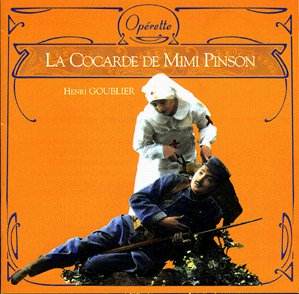This operetta is amongst
a series of 20 Musidisc sets that were
previously released as LPs and until
now have been lost from the catalogue.
Of the series, this
is one of the titles I have really enjoyed
listening to. The music is fresh-sounding
and carries bright melodies with interesting,
yet unobtrusive underscoring. Henri
Goublier is little known outside
France and information about his operettas
is scant. Turning to the Grove Dictionary
for facts I find there is nothing. There
is no mention in Traubner's brilliant
book 'Operetta' (about to be published
in a new edition), but an Internet page
does exist to help anyone wanting further
information.
Henri Goublier
was the son of a successful song-writing
composer. He studied music with help
from an older brother as well as a teacher-friend
of the family. He attended the Paris
Conservatoire, studying piano and harmony
under Xavier Leroux. After military
service he went as a musician to join
the Gaïeté Lyrique theatre
orchestra. Here he found a fascination
with a side of music lighter than that
found at the Conservatoire, and this
fired his imagination.
The music here is very
much in the mould of a Lehárian
style, not unlike The Merry Widow
(1905). To me much of its appeal comes
from the excellent performance, both
in quality of voice and the well judged
pacing of this 1965 production. The
piece was staged a year after the First
World War started and so a military
theme in La Cocarde appropriately
colours the music and plot. This is
not done in a brash way but with the
subtlety as used by Donizetti in ‘The
Daughter of the Regiment’ (La Fille
du Régiment). Along with
its march tunes, we find that much of
the score is written in a romantic 3/4
time. Goublier's orchestration is light
yet exacting, and has interesting undercurrents
of pleasant melody to add to the score's
appeal.
A ‘cocarde’ (cockade
in English) is normally a rosette worn
in the hat as emblem or badge of office.
Here it is an emblem from the French
flag worn on the chest by soldiers in
battle.
The scene opens in
a sewing workroom run by a Monsieur
Robichon and his associate Madame Frivolet
(a widow). They sell cockades to raise
money for a war charity. One of their
workers is Marie-Louise who falls in
love with Jean Robichon, the son of
her boss. As he is a lieutenant in the
army she makes a cocarde for him, but
in it she sews a gold coin for luck.
Jean is hurt during
battle. But the bullet does not kill
him because the coin Marie-Louise sewed
into the cocarde he had worn on his
breast had protected him.
At first Marie-Louise
does not tell him about the coin, but
by the end of the operetta Jean discovers
it and returns her love for him to provide
a happy ending.
Casting provides us
with a cast in excellent voice. They
are all good lyrical singers having,
unusually, superb acting abilities as
well. (This is judged from their portrayal
of characters in the dialogue sections.)
Liliane Berton as Marie-Louise
is a fine light soprano with vibrato
prominent in her first number. Peter
Gottlieb as Jean is a good, strong tenor
fitting his role as a lieutenant. As
might be expected, the French producers
have subtly introduced realistic sound
effects to enhance this performance.
(I cringe at the thought of those artificial
effects used in Britain's Decca Phase
4 series.)
A change in the sound
stage was noticed at tk.5 (CD2) where
the chorus is brittle and treble-heavy
while the orchestra becomes bass heavy.
The soloists are not affected, however.
I found the music interesting: CD1 tk.5
reveals simple yet effective orchestration
where the xylophone (coupled with flute
decoration) occupies a presence. CD1
tk.9 shows that this forgotten composer
is forward-looking and anticipates the
musicals likely be written ten and twenty
years later. It is unlikely that the
xylophone would have been widely used
in 1915 or was it introduced into the
score during a later revision?
Notes on Goublier and
the plot are in French.
Raymond Walker
Operette
series from Universal Accord reviewed
by Ray Walker
